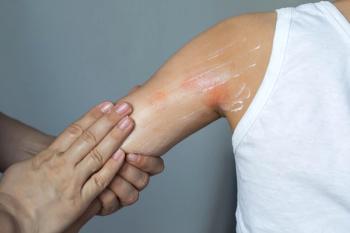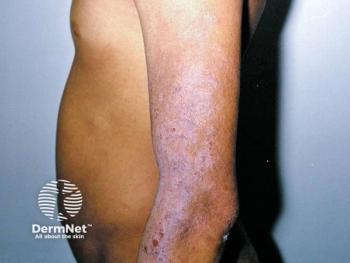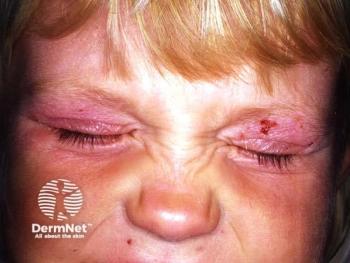
JAK Inhibitors in Atopic Dermatitis: Historical Use and Mechanisms of Action
Focusing on JAK inhibitors, panelists consider the historical use of these agents in atopic dermatitis and their corresponding mechanisms of action.
Episodes in this series

Transcript:
Christopher G. Bunick, MD, PhD: As we start our second segment, it’s going to be focused on JAK [Janus kinase] inhibitors and what they’re going to do for our atopic dermatitis patients. Dr Lio, I’ll start with you for this segment. Could you please talk about the trajectory of biologic and targeted therapies in atopic dermatitis, and how the landscape and attitudes towards these agents has been shifting over the past decade?
Peter A. Lio, MD: Absolutely. I think we’re lucky because those who have come before us have already outlined this trajectory. For example, with psoriasis, we’ve seen psoriasis go from the old commercial talking about the heartbreak of psoriasis, just sort of suffering with it, to the crudest topicals that we had, to some of the very, frankly, kind of dangerous immunosuppression medicines that were used with middling effect, to the first biologics in psoriasis, to increasingly refining this, and watching as the drugs we had get better, that treat to target has actually continued to elevate it as well.
So finally, after a long time of languishing with very little in atopic dermatitis, I think we’re finally seeing that. The discussion has gone from improving itch and improving the disease, to saying, “Hey, can we get EASI [Eczema Area and Severity Index]-75? Can we get 4 points or better on the itch scale?” Now we’re even going to the next level. What about EASI-90? What about IGA [Investigator Global Assessment] of 0 or 1, clear or almost clear? What about itch of 0 or 1?
So, it’s been so neat, as we get these new tools, I think that reframes the entire discussion so that we can say to a patient, well, maybe getting just a little bit better isn’t good enough. Now we actually have the potential to get you a heck of a lot better and maybe even clear or almost clear, nearly so.
Christopher G. Bunick, MD, PhD: Great, thank you. Dr Cohen, can you please discuss the mechanisms of JAK inhibitors in the treatment of atopic dermatitis? I believe understanding mechanisms of drugs is very important. So could you help us there?
Jeffrey Cohen, MD: Yes. The JAK, or Janus kinase proteins, are proteins that exist just downstream of the cytokine receptor. A lot of the medications that we already have for atopic dermatitis such as dupilumab [Dupixent], and a lot of the medications that we use for psoriasis, inhibit at the level of the cytokine. These cytokines are signaling molecules that attach to receptors on the outside of cells, telling the cell what to do. Once these cytokines attach their receptor on the outside of cells, the next step in signaling goes through these JAK proteins. The JAK proteins then become activated, they activate another protein that’s called STAT, which heads down to the nucleus of the cell where the DNA is, to tell the cell what to do.
Something that is different about the JAK inhibitors than a lot of the biologics that we have, is that they target a little bit more broadly. That is to say that each JAK is paired with multiple different cytokines. So whereas dupilumab targets 2 cytokines and tralokinumab [Adtralza] targets 1 cytokine, 1 JAK inhibitor actually targets a very large number of cytokines because they have the same JAK molecule or protein that’s associated with multiple different cytokine receptors.
In a condition like atopic dermatitis, where we’re learning every day about the heterogeneity and variability between patients in terms of their clinical appearance, but also the inflammation that underlies this condition, having something that’s a little bit broader like the JAK inhibitors apparently seems to work better. When you think about the underlying science and immunology, it makes sense that it would because it’s a little bit broader and is able to address multiple different cytokines that appear to play a very important role in the pathophysiology of atopic dermatitis.
Christopher G. Bunick, MD, PhD: Absolutely. I think that’s a really wonderful way to say it and it ties into what Dr Stein Gold said at the very beginning about the immune profile that we’re learning about atopic dermatitis.
Transcript edited for clarity.
Newsletter
Like what you’re reading? Subscribe to Dermatology Times for weekly updates on therapies, innovations, and real-world practice tips.



















